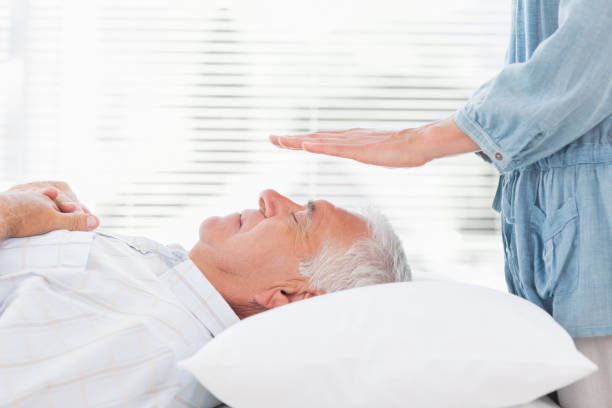Introduction

As researchers delve deeper into understanding Parkinson's disease, they continue to explore innovative ways to monitor its progression and improve patient care. Beyond the conventional methods of clinical examinations and motor assessments, a new avenue of investigation has emerged analyzing night breathing patterns. Sleep disturbances are common among individuals with Parkinson's disease, and recent studies have uncovered a potential link between nocturnal breathing patterns and the progression of the disease.
Learn about the significance of studying breathing patterns during sleep and their potential correlation with the advancement of Parkinson's disease. This blog post delves into how this information can enhance detection and treatment techniques. Explore the intriguing realm of nocturnal breathing patterns and their influence on monitoring the progression of Parkinson's disease.
What is Parkinson's Disease?
Parkinson's disease is a neurodegenerative disorder due to the loss of dopamine-producing cells in a region of the brain called the substantia nigra. Dopamine is a neurotransmitter responsible for facilitating smooth and coordinated movement. The loss of dopamine leads to the characteristic motor symptoms of Parkinson's disease.
Symptoms of Parkinson's Disease

Here are some Symptoms of Parkinson's Disease that may be seen in the early stages:
Tremors
One indication of Parkinson's Disease is tremors. The body experiences tremors, varying in intensity from mild to severe. They typically increase in severity during times of stress or physical activity. They can also occur while resting or sleeping. The severity of tremors can differ between individuals, with some experiencing no tremors.
Slowed Movement
Slowed movement is another symptom associated with Parkinson's Disease. People with the condition experience a decreased ability to initiate and perform physical activities. This can be seen in their everyday tasks, such as walking, writing, getting dressed, and eating. These movements become slower, causing the person to struggle with daily tasks.
Stiffness
Stiffness is another symptom associated with Parkinson's Disease. This can include changes in the muscles of the limbs and trunk, as well as difficulty moving certain parts of the body. It can also cause rigidity or a feeling of tightness around the limbs and joints. Additionally, stiffness can make maintaining balance while standing or walking difficult.
Impaired balance
Impaired balance is a common symptom of Parkinson's Disease. The patient might struggle with tasks such as standing up from a seated position, going up the stairs, or rotating their body because of problems with balance during walking or standing. Additionally, poor coordination and trembling can make it more difficult to keep one's balance. As Parkinson's Disease progresses, the patient may experience frequent falls or difficulty getting up from a fall.
Loss of automatic movements
Loss of automatic movements is another symptom of Parkinson's Disease. This includes difficulty with spontaneous facial expressions, such as smiling or blinking. The patient may also experience a decrease in hand-eye coordination and have difficulty performing tasks that require fine motor skills, like buttoning shirts or writing. Also, the patient might experience difficulty in starting movements like rising from bed or walking.
Speech changes, including soft
Speech changes, including soft or slurred speech, are another symptom associated with Parkinson's Disease. The patient may have difficulty speaking loudly and clearly, which can cause them to be difficult to understand. Additionally, the patient may experience rapid speech and a monotone voice. Sometimes, they may also experience freezing of their vocal cords, making speaking difficult. Speech therapists can help the patient learn techniques to improve their speech. Additionally, medication may be prescribed to help control the symptoms of Parkinson's Disease.
Writing changes
Writing changes are another symptom of Parkinson's Disease. This can include difficulty writing, forming letters and words on a page, and shaky handwriting. Additionally, the patient may experience difficulty with coordination when using utensils such as pens and pencils. A speech therapist can provide strategies for improving writing difficulties. Patients with Parkinson's Disease may be prescribed medication to manage their symptoms in certain situations.
Changes in facial expressions
Changes in facial expressions are another symptom associated with Parkinson's Disease. This can include difficulty smiling, frowning, or making other facial expressions. The patient may also experience decreased blinking and tearing of the eyes. Additionally, they may have difficulty speaking as the muscles used for speaking can become tight and rigid over time. Speech therapy is often recommended to help patients learn techniques for improving their facial expressions and speaking ability. Parkinson's Disease symptoms may sometimes be managed with prescribed medications.
Cognitive changes
Cognitive changes are another symptom of Parkinson's Disease. This can include impaired short-term memory, difficulty concentrating and focusing, and slowed reaction times. Additionally, the patient may need help with decision-making and planning ahead. They may also need help multitasking or switching between tasks quickly.
Occupational therapy and cognitive behavioral therapy are two types of therapies that can be beneficial in improving cognitive abilities. Additionally, medication may be prescribed to help control the symptoms of Parkinson's Disease.
Sleep disturbances
Sleep disturbances are another symptom of Parkinson's Disease. This message refers to experiencing sleep-related difficulties, such as difficulty falling asleep, difficulty staying asleep, or feeling unrested after sleeping. Additionally, the patient may experience nightmares, vivid dreams, and changes in night breathing patterns, such as apnea or hypopnea, that can signal disease progression. To help manage sleep disturbances, a doctor may prescribe medication or recommend behavioral strategies such as avoiding caffeine and other stimulants, creating a relaxing bedtime routine and ensuring the sleeping environment is dark and comfortable.
Additionally, monitoring night breathing patterns can provide valuable insights into disease progression. Therefore medical professionals are increasingly focusing on the role of night breathing patterns in monitoring Parkinson's Disease.
Current Methods of Monitoring Parkinson's Disease

Currently, the primary methods used to monitor the progression of Parkinson's disease clinical assessments, such as the Unified Parkinson's Disease Rating Scale (UPDRS), and neuroimaging techniques like magnetic resonance imaging (MRI) and positron emission tomography (PET) scans, are used. These methods provide valuable information about the motor symptoms and structural changes in the brain. However, they may not accurately capture the subtle changes during sleep or reflect the overall disease progression.
Night Breathing Patterns and Parkinson's Disease
The Importance of Sleep in Parkinson's Disease
Disturbances in sleep patterns are common among individuals with Parkinson's disease, and sleep is crucial for overall health and well-being. Sleep problems can exacerbate motor and non-motor symptoms and adversely affect the quality of life. Therefore, understanding sleep disturbances and their relationship to disease progression is crucial.
Sleep Disorders in Parkinson's Disease
People with Parkinson's disease often experience sleep disorders such as insomnia, restless legs syndrome (RLS), periodic limb movements during sleep (PLMS), and rapid eye movement (REM) sleep behavior disorder (RBD). Difficulty sleeping can greatly affect how you function during the day and could happen before physical symptoms occur.
Night Breathing Patterns as an Indicator of Disease Progression
Recent research has shown a potential link between night breathing patterns and Parkinson's disease progression. Breathing abnormalities during sleep, such as changes in respiratory rate, depth of breathing, and pauses in breathing, have been observed in individuals with Parkinson's disease. These patterns may serve as biomarkers for disease progression, allowing for early detection and intervention.
Research on Night Breathing Patterns
Studies Linking Night Breathing Patterns to Parkinson's Disease
Several studies have investigated the relationship between night breathing patterns and Parkinson's disease. According to an article in the Journal of Parkinson's Disease, people with Parkinson's disease have different breathing patterns during sleep compared to those unaffected by the condition. Another study published in Sleep Medicine revealed that changes in breathing patterns during REM sleep were associated with disease severity and motor symptoms in Parkinson's patients.
Technology and Devices Used to Monitor Breathing Patterns
Researchers have utilized various technologies and devices to monitor night breathing patterns, including polysomnography (PSG), which records brain waves, eye movements, muscle activity, and breathing patterns during sleep. Additionally, wearable devices, such as actigraphy monitors and smartwatches, have been employed to track respiratory parameters and sleep quality in individuals with Parkinson's disease.
Benefits and Limitations of Using Night Breathing Patterns as a Monitoring Tool
Using night breathing patterns as a monitoring tool for Parkinson's disease offers several potential benefits. It provides a non-invasive and continuous method of monitoring disease progression, allowing for early detection of changes and personalized treatment approaches. Furthermore, monitoring night breathing patterns may also help differentiate Parkinson's disease from other sleep-related disorders.
However, there are limitations to consider. Night breathing patterns can be influenced by factors other than Parkinson's disease, such as aging, obesity, and comorbidities. Additionally, the availability and accessibility of monitoring devices may vary, limiting their widespread use in clinical settings.
Implications for Parkinson's Disease Management
Early Detection and Intervention
Monitoring night breathing patterns in individuals with Parkinson's can facilitate early disease progression detection. By identifying changes in respiratory patterns during sleep, healthcare professionals can intervene early, potentially improving patient treatment outcomes and quality of life.
Personalized Treatment Approaches
Understanding the relationship between night breathing patterns and Parkinson's disease progression can aid in developing personalized treatment approaches. By incorporating data from breathing pattern monitoring, healthcare providers can tailor interventions to target specific symptoms and address individual needs, improving the effectiveness of treatment strategies.
FAQ's
What is the utility of breath analysis in diagnosing and staging Parkinson's disease?
Breath analysis offers a non-invasive and continuous method of monitoring disease progression, allowing for early detection of changes. Additionally, it may help differentiate Parkinson's disease from other sleep-related disorders and aid in developing personalized treatment approaches.
What types of technology are used to monitor breathing patterns?
The technology for monitoring breathing patterns includes polysomnography (PSG) and wearable devices such as actigraphy monitors and smartwatches.
Does breathing help Parkinson's?
Breathing does not directly help reduce the symptoms of Parkinson's disease. However, monitoring night breathing patterns is useful for early detection and intervention, enabling healthcare professionals to customize treatment approaches to target specific symptoms.
Is sleep apnea common in Parkinson's disease?
Individuals with Parkinson's disease commonly experience sleep apnea, which is a sleep disorder. Various factors, such as decreased lung capacity and medication side effects, can cause it. Monitoring night breathing patterns can help differentiate between sleep apnea and other respiratory issues associated with Parkinson's disease.
Can Parkinson's cause low oxygen?
Parkinson's disease can cause changes in breathing patterns that can reduce oxygen levels during sleep. It is important to monitor these patterns and seek treatment if there are any signs of decreased oxygenation.
Conclusion
In conclusion, monitoring night breathing patterns can provide valuable insight into disease progression and aid in developing personalized treatment approaches for individuals with Parkinson's disease. With the availability of monitoring devices, it is becoming increasingly possible to track changes in respiratory patterns during sleep and intervene early. While there are some limitations to consider, the potential benefits of breath analysis make it an important tool for managing Parkinson's disease.

